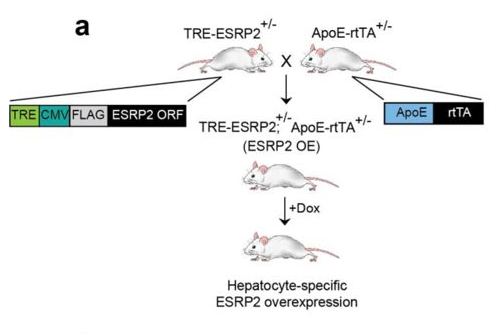|
|
Developmental biology - Cell Regeneration
Our Liver Can Regenerate Itself
Damaged liver cells undergo reprogramming in order to regenerate and may teach us how to regenerate other tissue...
In Greek mythology, Zeus punishes the trickster Prometheus by chaining him to a rock and sending an eagle to eat a portion of his liver every day in perpetuity. That was the right organ to target as out liver has the ability to regenerate itself - though not overnight and not for eternity.
New research conducted by biochemists at the University of Illinois (U of I) has determined how damaged liver cells repair and restore themselves. Liver cells send out a signal to return mature cells into an early stage of postnatal organ development. These findings appear in the journal Nature Structural & Molecular Biology.
"The liver is a resilient organ. It can restore up to 70 percent of lost mass and function after just a few weeks. We know that in a healthy adult liver, the cells are dormant and rarely undergo cell division. However, if the liver is damaged, the liver cells re-enter the cell cycle to divide and produce more of themselves. This research looked at what is happening at the molecular level in a damaged liver that enables it to regenerate while still performing normal functions."
Auinash Kalsotra PhD, Professor Department of Biochemistry, University of Illinois Urbana-Champaign, Urbana, IL, USA; Carl R. Woese Institute of Genomic Biology, University of Illinois Urbana-Champaign, Urbana, IL, USA and research leader.
The human liver can become chronically damaged by toxins such as alcohol and even certain medicines, but still continue to function and self-repair, Kalsotra explains.
Using a mouse model of liver severely damaged by toxins, researchers compared injured adult liver cells with healthy cells present during a stage of organ development begun just after birth. Researchers found that injured cells undergo a partial reprograming which returns them to a neonatal state of gene expression.
 Eight-week-old adult bitransgenic and littermate control (ApoE-rtTA) mice were fed doxycycline
Eight-week-old adult bitransgenic and littermate control (ApoE-rtTA) mice were fed doxycycline
(Dox)-containing diet for 2 weeks to induce FLAG-ESRP2 expression specifically in hepatocytes.
Fragments of messenger RNA, the molecular blueprints for proteins, were found rearranged and processed to regenerate liver cells reminiscent of that neonatal period of development. This phenomenon is regulated through alternative splicing, a process where exons (functioning regions of genes) are cut from introns (intervening gene regions) and stitched together in various combinations to produce many different proteins from a single gene, which have different cellular functions and properties.
"We found that the liver cells after birth use a specific RNA-binding protein called ESRP2 to generate an assortment of alternatively spliced RNAs which can produce protein products meeting the functional demands of an adult liver. When damaged, liver cells lower the quantity of ESRP2. This reactivates fetal RNA splicing - called the 'Hippo signaling pathway' - giving it instructions to restore and repopulate with new, healthy cells."
Sushant Bangru, Doctural canidate, Department of Biochemistry, University of Illinois Urbana-Champaign, Urbana, IL, USA and lead author of the study.
Kalsotra described the science in mythological terms: "When Zeus' eagle comes in for its daily snack, damaging the liver, the alternatively spliced form of Hippos come into play - repairing Prometheus's liver so the poor guy can go through this whole punishment again the next day."
Abstract
During liver regeneration, most new hepatocytes arise via self-duplication; yet, the underlying mechanisms that drive hepatocyte proliferation following injury remain poorly defined. By combining high-resolution transcriptome and polysome profiling of hepatocytes purified from quiescent and toxin-injured mouse livers, we uncover pervasive alterations in messenger RNA translation of metabolic and RNA-processing factors, which modulate the protein levels of a set of splicing regulators. Specifically, downregulation of the splicing regulator ESRP2 activates a neonatal alternative splicing program that rewires the Hippo signaling pathway in regenerating hepatocytes. We show that production of neonatal splice isoforms attenuates Hippo signaling, enables greater transcriptional activation of downstream target genes, and facilitates liver regeneration. We further demonstrate that ESRP2 deletion in mice causes excessive hepatocyte proliferation upon injury, whereas forced expression of ESRP2 inhibits proliferation by suppressing the expression of neonatal Hippo pathway isoforms. Thus, our findings reveal an alternative splicing axis that supports regeneration following chronic liver injury.
Authors
Sushant Bangru, Waqar Arif, Joseph Seimetz, Amruta Bhate, Jackie Chen, Edrees H. Rashan, Russ P. Carstens, Sayeepriyadarshini Anakk and Auinash Kalsotra.
Acknowledgements
The National Institutes of Health, March of Dimes and American Heart Association supported this research.
The authors the members of the Kalsotra and Anakk laboratories for their valuable discussions and comments on the manuscript. This research was supported through NIH (R01HL126845) and March of Dimes (5-FY14-112) grants to A.K. and NIH (R01AI081710) to S.A. W.A. was supported by the NIH predoctoral NRSA fellowship (F30DK108567). J.S. was partly supported by the NIH Chemistry–Biology Interface Training Grant (5T32-GM070421) and the American Heart Association predoctoral fellowship (17PRE33670030). A.B. was partly supported by the Herbert E. Carter fellowship in Biochemistry, UIUC. Three cores at UIUC supported this project: Transgenic Mouse Facility Core, High-Throughput Sequencing and Genotyping Core, and Histology and Microscopy Core.
Return to top of page
| |
|
Oct 3, 2018 Fetal Timeline Maternal Timeline News News Archive
 To steal fire from the gods of Mount Olympus and give it to humans, Prometheus creates a clay figure of a human being to fool them. As punishment, the gods chain him to Mount Caucasus where daily an eagle attacks and eats his liver. But his liver grows back, again and again. In fact, our liver is capable of regenerating. Image: Peter Paul Ruebens, the Philadelphia Museum of Art.
|




